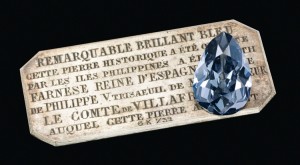The Journey of the Farnese Blue
Thursday, May 17th, 2018May 17, 2018
On Tuesday, May 15, one of the world’s most beautiful and historic diamonds, the Farnese Blue, sold at auction in Switzerland for $6.7 million. The Farnese Blue is not the most expensive diamond on the planet—that honor currently goes to the $57.5-million Oppenheimer Blue, the world’s largest blue diamond. But $6.7 million is still a lot for a single gem, and the 6.16-carat pear-shaped Farnese Blue has had a fascinating journey that goes right along with the history books.

A silver marker is included in the box with the Farnese Blue diamond. In French, it reads: “Remarkable blue brilliant. This historical stone was offered by the Philippine Islands to Elisabeth Farnese, Queen of Spain, wife of Philippe V, great grandfather of the Comte de Villafranca, current owner of that stone.” Credit: © Sothebys
Tuesday’s auction at Sotheby’s in Geneva was the first public sale of the Farnese Blue, which had remained in the same family for centuries. Part of a bank-busting sale collection called “Magnificent Jewels and Noble Jewels,” the Farnese Blue was purchased by an unnamed private collector. Like many other famous diamonds, the Farnese Blue came from the historic Golconda mines of southern India.
Historically, the Farnese Blue can be traced back to Elisabeth Farnese, the queen of Spain from 1714 to 1746. At the time of her marriage to King Philip V in 1714, the Spanish monarchy was reeling from years of fighting in the War of the Spanish Succession. Badly in debt, the king appealed to Spain’s colonies around the world to provide wedding gifts for his new bride. Eventually, an enormous amount of gold and gems was loaded onto 12 ships, a so-called “Golden Fleet” that set sail from Cuba in August 1715, bound for Spain. Not long after leaving port, however, a hurricane destroyed all but one ship of the Golden Fleet—a ship carrying treasures, the Blue Farnese among them, collected by the governor of the Philippines, a Spanish colony at the time. Queen Elisabeth (and no doubt a frustrated King Philip) missed out on the bulk of the expensive gifts, but she had a shiny new blue diamond.
The Farnese Blue then passed down through Philippe, a younger son of Elisabeth and Philip who became the duke of Parma, Elisabeth’s hometown in Italy. The stone then went to Philippe’s son Ferdinand, the second duke of Parma. Ferdinand’s son Louis got the diamond before his brief reign as king of Etruria (present-day Tuscany, Umbria, and Latium) during the tumultuous years of the Napoleonic Wars (1796-1815). Louis’s son Charles, who after a roundabout path ended up as the Comte de Villafranca, left the Farnese Blue to his grandson, Robert, the last duke of Parma.
After the Risorgimento (the unification of Italy in the 1860′s), Robert lived with other deposed Italian dukes in neighboring Austria-Hungary, which was then ruled by Robert’s cousin, the Habsburg Emperor Franz Joseph. Robert’s son, Prince Elie, included the diamond in the wedding presents to his wife Maria Anna in 1903. The Austro-Hungarian Monarchy fell at the end of World War I (1914-1918), and with it went the royal status of the House of Habsburg. Maria Anna kept the Farnese Blue in the now private family, however, and the diamond passed down through successive generations until its eventual sale this week.


